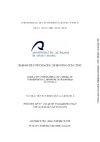Please use this identifier to cite or link to this item:
https://accedacris.ulpgc.es/jspui/handle/10553/62680
| Title: | Simulación experimental del sistema de corrientes en el Estrecho de Bransfieldn (Antártida) | Authors: | Hernandez Arencibia, Monica | Director: | Marrero Díaz, Ángeles Rodríguez Santana, Ángel |
UNESCO Clasification: | 2510 Oceanografía | Keywords: | Corrientes marinas Estrecho de Bransfield Modela experimental |
Issue Date: | 2006 | Abstract: | En este trabajo se realiza la puesta a punto de una mesa rotatoria. Gracias a este sistema, se puede simular la rotación terrestre y realizar simulaciones de fluidos geofísicos. En este caso, el objetivo es simular el sistema de corrientes de la Cuenca Central del Estrecho de Bransfield, situado en la Antártida. En particular, una corriente intensa que circula a lo largo del margen nororiental de dicho estrecho y que se conoce como Corriente de Bransfield. Existen numerosos estudios realizados en la zona gracias a los cuales se conoce bastante su hidrografía; sin embargo, hay aspectos de su dinámica que todavía se desconocen. Con las simulaciones de laboratorio realizadas en este trabajo se pretende comprobar la validez de la hipótesis de que el sistema de corrientes en el Estrecho de Bransfield se comporta como un sistema de corriente de gravedad entre los dos tipos de agua que entran en contacto en los primeros metros de la columna de agua. Para llevar a cabo los objetivos de este estudio, se ha tenido que realizar un análisis de escala para establecer relaciones de diferentes parámetros entre la naturaleza y el prototipo del laboratorio, y así, determinar los parámetros esenciales para las simulaciones (velocidad de giro, densidad de los dos fluidos en el laboratorio, etc.). Se realizaron simulaciones con fondo plano y con la presencia de la batimetría de los primeros 600m gracias a la elaboración de una maqueta; tanto en sistemas en reposo como rotantes. Para realizar el posterior análisis de las simulaciones se han colocado dos cámaras digitales, una en posición cenital y otra en la lateral. Con las simulaciones realizadas se ha podido obtener resultados cualitativamente comparables con los datos in situ obtenidos por Zhou et al. (2002) o por campañas oceanográficas como BREDDIES (Gordo et al., 2006). Los rasgos de la Corriente de Bransfield que aparecen en los trabajos mencionados se reproducen en las simulaciones realizadas en el laboratorio, aunque debe mejorarse la simulación para poder realizar comparaciones cuantitativas. In this work a new branch of investigation has been begun making a rotary table operative. Using this system, it is possible to simulate the rotation of Earth and phenomena related with geophysical fluids. In this case, the aim is the simulation of the Strait Bransfield Central Basin currents systems, located in the Antarctica. Although there are numerous studies done in the zone that have allowed describing his hydrography, there are aspects of its dynamics that still are not known. With the simulations of laboratory made in this work it is tried to verify the validity of the hypothesis that postulates that the system of current in the Bransfield Strait behaves like a system of gravity current in the first meters of the water column. In order to carry out the aims of this study, it has made a dimensional analysis to establish relations between different parameters between the nature and the laboratory's prototype, and thus, to determine the essential parameters for the simulations. Simulations with flat bottom and the presence of the bathymetry of the first 600m were made thanks to the elaboration of a scale model; as much in systems in rest as rotating. In order to make the later simulations analysis it was used two digital cameras, with both cenital and lateral placement. With the simulations it has been possible to obtain qualitatively comparable results with the in situ data obtained by Zhou et al. (2002) or by oceanographic cruise BREDDIES (Gordo et al., 2006). Although al1 the results cannot quantitatively be comparable, this work has been worth the hypothesis of gravity current without need to impose western boundary currents as other authors affirm. |
Faculty: | Facultad de Ciencias del Mar | URI: | https://accedacris.ulpgc.es/handle/10553/62680 | Rights: | Acceso restringido para la comunidad universitaria de la ULPGC |
| Appears in Collections: | Proyecto fin de carrera Restringido ULPGC |
En el caso de que no encuentre el documento puede ser debido a que el centro o las/os autoras/es no autorizan su publicación. Si tiene verdadero interés en el contenido del mismo, puede dirigirse al director/a o directores/as del trabajo cuyos datos encontrará más arriba.
Show full item recordPage view(s)
128
checked on Feb 10, 2024
Download(s)
13
checked on Feb 10, 2024
Google ScholarTM
Check
Share
Export metadata
Items in accedaCRIS are protected by copyright, with all rights reserved, unless otherwise indicated.
